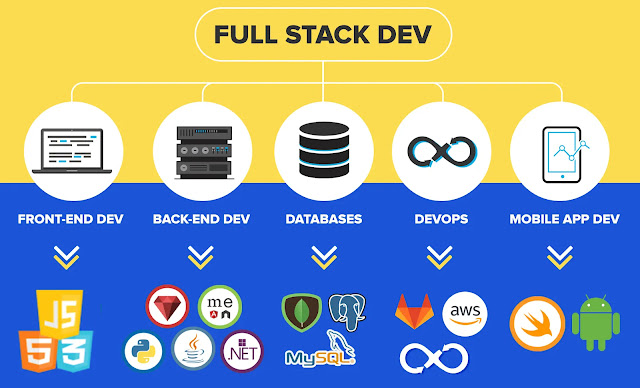Full-Stack Web Development — the Complete Roadmap
Introduction
In today's digital age, web development has become an integral part of our lives. Full-stack web development, in particular, has gained immense popularity due to its ability to handle both the front-end and back-end aspects of web applications. In this article, we will explore the complete roadmap of full-stack web development, including its importance, essential skills, learning path, tools, and career opportunities.
Importance and Benefits of Full-Stack Web Development
Full-stack web development offers numerous benefits. Firstly, it allows developers to have a holistic understanding of the entire web development process, from designing user interfaces to managing databases. This comprehensive knowledge enables developers to build efficient and scalable web applications. Additionally, full-stack developers have the versatility to work on both client-side and server-side components, making them valuable assets for companies looking to streamline their development processes.
Essential Skills for Full-Stack Web Developers
To excel in full-stack web development, developers need to acquire a diverse set of skills. Here are some essential skills for full-stack web developers:
- Front-End Development Skills: Proficiency in HTML, CSS, and JavaScript is crucial for building intuitive user interfaces.
- Back-End Development Skills: Knowledge of back-end technologies such as Node.js, Ruby on Rails, or Django is essential for handling server-side logic.
- Database Skills: Familiarity with database management systems like MySQL, MongoDB, or PostgreSQL is necessary to store and retrieve data effectively.
- Version Control Skills: Proficiency in using version control systems like Git enables developers to collaborate on projects, track changes, and manage code efficiently.
- UX/UI Design Skills: Understanding user experience (UX) and user interface (UI) design principles helps in creating visually appealing and user-friendly web applications.
- Testing and Debugging Skills: Full-stack developers should possess skills in testing and debugging techniques to identify and resolve issues in their applications.
Full-Stack Web Development Roadmap
To embark on the full-stack web development journey, follow this roadmap:
- Learning HTML, CSS, and JavaScript: Start by mastering the fundamentals of web development, including HTML for creating website structure, CSS for styling, and JavaScript for interactive functionality.
- Understanding Front-End Frameworks: Dive deeper into front-end development by learning popular frameworks like React, Angular, or Vue.js, which facilitate efficient UI development.
- Mastering Back-End Technologies: Acquire knowledge of back-end technologies such as Node.js, Python, or Ruby on Rails to build server-side logic and handle requests.
- Working with Databases: Explore various database technologies and learn how to integrate databases like MySQL, MongoDB, or PostgreSQL into your applications.
- Learning Version Control Systems: Familiarize yourself with Git, the most widely used version control system, to track changes, collaborate with other developers, and maintain code integrity.
- Enhancing UX/UI Design Skills: Gain insights into UX/UI design principles and learn tools like Adobe XD or Sketch to create visually appealing and intuitive interfaces.
- Testing and Debugging Techniques: Develop skills in writing test cases, performing unit testing, and using debugging tools to ensure the quality and reliability of your code.
- Continuous Learning and Keeping Up with Technology: Stay updated with the latest trends and advancements in web development, as technology evolves rapidly in this field.
Tools and Technologies for Full-Stack Web Development
A wide range of tools and technologies are available to aid full-stack web developers. Here are some essential ones:
- Front-End Tools and Frameworks: React, Angular, Vue.js, Bootstrap, and Sass are popular front-end tools and frameworks that streamline development processes.
- Back-End Tools and Frameworks: Node.js, Express.js, Django, and Ruby on Rails are widely used back-end tools and frameworks that simplify server-side development.
- Database Technologies: MySQL, MongoDB, PostgreSQL, and Firebase offer robust database management solutions with different strengths and use cases.
- Version Control Systems: Git, along with platforms like GitHub or GitLab, provides version control capabilities and facilitates collaboration among developers.
- UI/UX Design Tools: Adobe XD, Sketch, Figma, and InVision are popular design tools that help create visually appealing and interactive user interfaces.
- Testing and Debugging Tools: Tools like Jest, Mocha, Chai, and Postman assist in testing and debugging processes, ensuring the quality and functionality of your code.
Building a Full-Stack Web Application
To build a full-stack web application, follow these steps:
- Planning and Defining Requirements: Understand the project scope, gather requirements, and create a plan for the web application.
- Designing the User Interface: Utilize your UX/UI design skills to create wireframes and design mockups that align with the project requirements.
- Developing the Front-End: Implement the user interface using HTML, CSS, and JavaScript, incorporating front-end frameworks for efficiency.
Building a Full-Stack Web Application
Creating the Back-End Functionality: Develop the back-end logic using your chosen technology stack, handling server-side operations, and integrating APIs.
- Integrating Databases: Set up and configure the chosen database system, create the necessary tables, and establish connections for data storage and retrieval.
- Testing and Quality Assurance: Conduct thorough testing to ensure the functionality, performance, and security of your application. Implement automated tests and perform manual testing to identify and fix any issues.
- Deployment and Maintenance: Deploy your application to a hosting environment or cloud platform, ensuring proper configuration and security measures. Regularly maintain and update your application to keep it secure and up to date.
Career Opportunities in Full-Stack Web Development
Full-stack web development offers various career opportunities:
- Full-Stack Developer: As a full-stack developer, you can work on both the front-end and back-end aspects of web development, creating end-to-end solutions.
- Web Application Developer: Focus on developing robust web applications, collaborating with teams to deliver user-friendly and efficient products.
- Freelancing and Entrepreneurship: With full-stack skills, you can work as a freelancer, offering web development services to clients, or start your own web development business.
Conclusion
Full-stack web development is a dynamic and rewarding field that allows developers to have a comprehensive understanding of the entire web development process. By acquiring the essential skills, following a structured roadmap, and leveraging the right tools, you can become a proficient full-stack developer capable of building scalable and innovative web applications.


.jpg)
Comments
Post a Comment